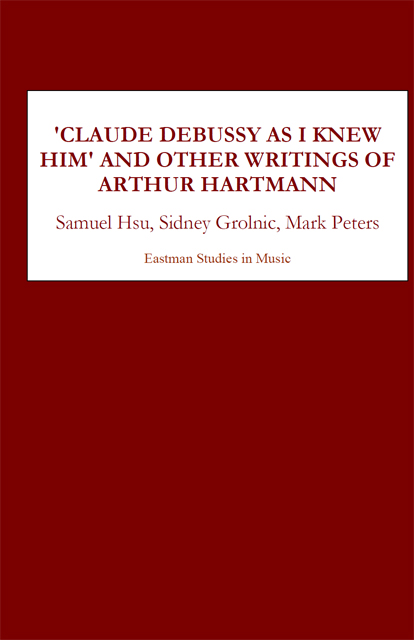Book contents
- Frontmatter
- Dedication
- Contents
- List of Photographs
- List of Facsimiles
- List of Music Examples
- List of Correspondence
- Foreword by David Grayson
- Preface
- Part 1 Arthur Hartmann
- Part 2 Claude Debussy
- Part 3 Other Writings of Arthur Hartmann
- Appendix A The Minstrels Manuscripts
- Appendix B Three Letters from Claude Debussy to Pierre Louÿs
- Arthur Hartmann: Catalogue of Compositions and Transcriptions
- Notes
- Archival Sources
- Bibliography
- Index
Preface
Published online by Cambridge University Press: 17 March 2023
- Frontmatter
- Dedication
- Contents
- List of Photographs
- List of Facsimiles
- List of Music Examples
- List of Correspondence
- Foreword by David Grayson
- Preface
- Part 1 Arthur Hartmann
- Part 2 Claude Debussy
- Part 3 Other Writings of Arthur Hartmann
- Appendix A The Minstrels Manuscripts
- Appendix B Three Letters from Claude Debussy to Pierre Louÿs
- Arthur Hartmann: Catalogue of Compositions and Transcriptions
- Notes
- Archival Sources
- Bibliography
- Index
Summary
During the first quarter of the twentieth century, Arthur Hartmann (1881– 1956) was celebrated as one of the world's finest violinists. He performed over a thousand recitals throughout Europe and the United States and consistently received critical acclaim for the sensitivity and passion of his playing. He also composed a respectable body of instrumental and vocal works and was particularly well known for the over two hundred transcriptions he created for violin and piano. Several of these became staples on the programs of such colleagues as Mischa Elman, Jascha Heifetz, Fritz Kreisler, Yehudi Menuhin, Maud Powell, and Jacques Thibaud.
Hartmann also wrote pedagogical articles on violin technique and was considered an authority on Bach's violin works, particularly the Chaconne. He was highly regarded as a teacher and was recruited in 1918 for the faculty of the DKG Institute of Musical Art, which became the Eastman School of Music in 1921. In Rochester, Hartmann led the Kilbourn Quartet, which performed weekly in George Eastman's mansion for his friends and guests. Leaving Eastman in 1922, he soon formed the Hartmann Quartet, which specialized in bringing to American audiences works by Frank Bridge, Alfred Casella, Ernst von Dohnányi, Eugene Goossens, and other contemporaries, as well as the standard repertoire.
His fellow musicians, from Leopold Auer to Efrem Zimbalist, valued his friendship and enjoyed his legendary abilities as a raconteur and musical mimic. Throughout his life, Hartmann was fascinated with meeting famous people, and his wit, talent, and ingratiating personality endeared him to such major figures as Eugène Ysaÿe, Edvard Grieg, and, above all, Claude Debussy. In a letter to Louis Laloy dated 5 January 1914, Debussy wrote: “[Hartmann] est intéressant et joue prodigieusement du violon” (“[Hartmann] is an engaging person and an extraordinary violinist”).
Up to now, little has been known about the relationship between Debussy and Hartmann, except for the fact that the composer accompanied the violinist in a program on 5 February 1914 that featured Hartmann's transcriptions of Debussy's Il pleure dans mon coeur, La fille aux cheveux de lin, and Minstrels. Now with the publication of Hartmann's memoir “Claude Debussy As I Knew Him,” along with the letters from the composer and his wife, Emma, to the violinist and his wife, Marie, the richness of their relationship can be appreciated.
- Type
- Chapter
- Information
- Publisher: Boydell & BrewerPrint publication year: 2004



